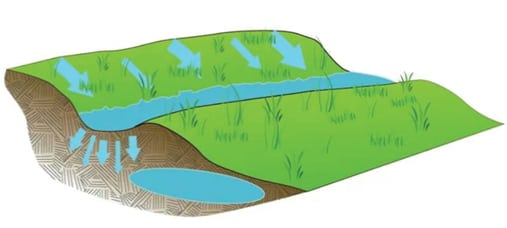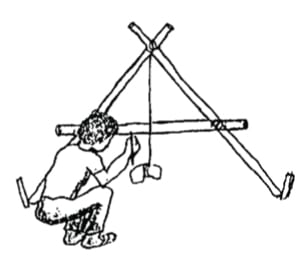How to Harvest More Rain in the Landscape with Swales
A swale is a ditch that is dug on contour, meaning that it runs perfectly level across the landscape.
 Swales are a great way to slow, spread and sink excess rainwater that would normally runoff.
Swales are a great way to slow, spread and sink excess rainwater that would normally runoff.
Swales can be as big or as small as you like and should always have a spillway designed to shed excess water.
When a swale is dug out, the excavated soil is put on the downhill side of the ditch, forming a berm. This berm should be planted so that the roots help strengthen and hold the berm in place.
Swales harvest water which sheets downhill in a rainstorm and they can also be used to harvest water from downspouts or curb cuts.
Swales can be left as an open ditch or filled in with mulch.
Using an A-Frame to Measure Contour Lines
An A-Frame Level is a low-tech device that consists of three boards and a string with a weight on the end. You can use it to find contour lines.
To make an A-Frame Level
- Attach three boards in the shape of a capital “A” with two equal length legs
- Attach a string to the top of the “A” and hang a weight on the other end.
- Make sure the string extends beyond the crossbar of the “A”
 To Calibrate an A-Frame Level
To Calibrate an A-Frame Level
- Place the A-Frame on a level (or nearly level) surface and mark the spot where the two legs rest
- Let the string hang down freely until it comes to rest against the crossbar
- Mark the spot where the string rests against the crossbar
- Flip the A-Frame around so that the legs are in the opposite spots
- Let the string hang freely and mark where it rests against the crossbar
- The midway point between the two marks on the crossbar is the level line
- Mark this level line with a big mark.
Using the A-Frame Level
- Now that it’s calibrated, you can use the A-Frame to find contour lines.
- Mark the location of one foot of the A-Frame and move the other foot around until the string hangs against the level line.
- Mark where the second foot rests
- Swing the first foot around until the string rests against the level line, and mark where the foot rests.
- Continue to walk the A-Frame across the landscape, marking each spot with a flag or stick.
Calculating Appropriate Swale and Rain Tank Size
The first thing that needs to be determined in swale design is how much rainwater will be diverted into it. If rain water is coming from the roof surface through a disconnected down spout, then rainfall in gallons can be predicted with the following equation:
A x R x 7.5 gal/ft3 = Total Rainwater (gal)
- A = Catchment area in square feet (length X width)
- R = Rainfall in feet = Rainfall in inches / 12
- There are about 7.5 gallons per cubic foot
Remember: You can collect 600 gallons of water per inch of rain falling on 1,000 square feet of catchment surface.
Once the number of gallons entering the swale has been determined, you can use the following equation to determine how big your swale needs to be to hold the majority of the water during a high flow rain event:
Total Rainwater = A x R x 7.5 gal/ft3 vs.
Swale Volume (gal) = 0.5 depth (feet) x width (feet) x length (feet) x 7.5 gal/ft3
- A = Catchment area in square feet (length X width)
- R = Rainfall in feet = Rainfall in inches / 12
- There are about 7.5 gallons per cubic foot
- Factor in the number of inches received in a high flow event
Remember to take the results of your Soil Composition and Percolation Test into account, as these will affect the swales water holding capacity, if the soils are slow draining.
A few more things to note about sizing your swales. Most residential properties will not have enough surface area to accommodate a high flow event, so take the swale volume calculation with a grain of salt. Regardless, all swales will need to have an overflow option to allow for excess water to leave the system without compromising the integrity of your swales (i.e. erosion).


